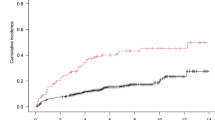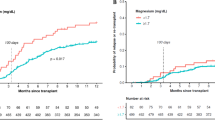Abstract
Insulin-like growth factor binding protein (IGFBP)-2 has mitogenic effects in normal and neoplastic cells. The purpose of this study is to examine the diagnostic and prognostic significance of elevated IGFBP-2 levels in children with AML after hematopoietic stem cell transplantation (HSCT) at relapse and continuous complete remission (CCR). In 27 children with AML (mean age 13.6±5.3 years; patients in remission n=15 with relapse n=12) serum parameters of IGFBP-2, IGFBP-3, IGF-I and IGF-II were analyzed up to 18 months after HSCT by RIA. AML-patients with evidence of relapse demonstrated a continuous increase of IGFBP-2 levels during the follow-up. At day 100 after HSCT, IGFBP-2 concentrations were significantly higher in patients with relapse than in children without relapse (7.4±4.0 standard deviation score (SDS) vs 3.9±1.7 SDS; P=0.01). Serum IGFBP-2 was identified as an independent factor for the prediction of relapse. Furthermore, the probability of relapse-free survival (RFS) in patients with IGFBP-2 >4.5 SDS at day 100 after HSCT was 31% compared to patients with IGFBP-2 <4.5 SDS was 72% (P=0.004). Patients with IGFBP-2 concentration up to 4.5 SDS more likely developed a relapse and had a poorer outcome. Identification of these patients allows a more individualized and aggressive adjuvant treatment and follow-up.
This is a preview of subscription content, access via your institution
Access options
Subscribe to this journal
Receive 12 print issues and online access
$259.00 per year
only $21.58 per issue
Buy this article
- Purchase on Springer Link
- Instant access to full article PDF
Prices may be subject to local taxes which are calculated during checkout


Similar content being viewed by others
References
Creuzig U, Ritter J, Zimmermann M, Reinhardt D, Hermann J, Berthold F et al. Improved treatment results in high-risk pediatric acute myeloid leukemia patients after intensification with high-dose cytarabine and mitoxantrone: results of Study Acute Myeloid Leukemia-Berlin-Frankfurt-Münster 93. J Clin Oncol 2001; 19: 2705–2713.
Ortega JJ, Diaz de Heredia C, Olive T, Bastida P, Llort A, Armadan L et al. Allogeneic and autologous bone marrow transplantation after consolidation therapy in high-risk acute myeloid leukemia in children. Towards a risk-oriented therapy. Haematologica 2003; 88: 290–299.
Woods WG, Neudorf S, Gold S, Sanders J, Buckley JD, Barnard DR et al. A comparison of allogeneic bone marrow transplantation, autologous bone marrow transplantation, and aggressive chemotherapy in children with acute myeloid leukemia in remission. Blood 2001; 97: 56–62.
Creutzig U, Ritter J, Zimmermann M, Schellong G . Does cranial irritation reduce the risk for bone marrow relapse in acute myelogenous leukemia? Unexpected results of childhood. AML Study-87. J Clin Oncol 1993; 11: 279–286.
Loeb DM, Arceci RJ . What is the optimal therapy for childhood AML? Oncology (Huntington) 2002; 16: 1057–1066; discussion 1066, 1068–1070.
Lanvers C, Reinhardt D, Dubbers A . Pharmacology of all-trans-retinoic acid in children with acute promyelocytic leukemia. Med Pediatr Oncol 2003; 40: 293–301.
Klein B, Tarte K, Jourdan M, Mathouk K, Moreaux J, Joudan E et al. Survival and proliferation factors of normal and malignant plasma cells. Int J Hematol 2003; 78: 106–113.
Busund LT, Richardsen E, Busund R, Ukkonem T, Bjornsen T, Busch C et al. Significant expression of IGFBP2 in breast cancer compared with benign lesions. J Clin Pathol 2005; 58: 361–366.
Kim HS, Ingermann AR, Tsubaki J, Twigg SM, Walker GF, Oh Y . Insulin-like growth factor-binding protein 3 induces caspase-dependent apoptosis through a death receptor-mediated pathway in MCF-7 human breast cancer cells. Cancer Res 2004; 64: 2229–2237.
Dupont J, Pierre A, Froment P, Moreau C . The insulin-like growth factor axis in cell cycle progression. Horm Metab Res 2003; 35: 740–750.
Drop SL, Schuller AG, Lindenbergh-Kortleve DJ, Groffen C, Brinkman A, Zwarthoff EC . Structural aspects of the IGFBP family. Growth Regul 1992; 2: 69–79.
Duan C, Xu Q . Roles of insulin-like growth factor (IGF) binding proteins in regulating IGF actions. Gen Comp Endocrinol 2005; 142: 44–52.
Yu H, Nicar MR, Shi R, Berkeltt J, Nam R, Trachtenberg J et al. Levels of insulin-like growth factor-I (IGF-I) and IGF-binding proteins -2 and -3 in serial postoperative serum samples and risk of prostate cancer recurrence. Urology 2001; 57: 471–475.
Elmlinger MW, Sanatani MS, Bell M, Dannecker GE, Ranke MB . Elevated insulin-like growth factor (IGF) binding protein (IGFBP)-2 and IGFBP-4 expression of leukemic T-cells is affected by autocrine/paracrine IGF-II action but not by IGF type I receptor expression. Eur J Endocrinol 1998; 138: 337–343.
Lee EJ, Mircean C, Shmulevich I, Wang H, Liu J, Niemisto A et al. Insulin-like growth factor binding protein 2 promotes ovarian cancer cell invasion. Mol Cancer 2005; 4: 7.
Dawczynski K, Kauf E, Zintl F . Changes of serum factors (IGF-I,-II and IGFBP-2,-3) prior to and after stem cell transplantation in children with acute leukemia. Bone Marrow Transplant 2003; 32: 411–415.
Blum WF, Breier BH . Radioimmunoassays for IGFs and IGFBPs. Growth Regul 1994; 4 (Suppl 1): 11–19.
Blum WF, Horn N, Kratzsch J, Jorgensen JO, Juul A, Teale D et al. Clinical studies of IGFBP-2 by radioimmunoassay. Growth Regul 1993; 3: 100–104.
Frystyk J, Ivarsen P, Stoving RK, Dall R, Bek T, Hagen C et al. Determination of free insulin-like growth factor-I in human serum: comparison of ultrafiltration and direct immunoradiometric assay. Growth Horm IGF Res 2001; 11: 117–127.
Cicognani A, Cacciari E, Pession A, Passini A, De Jasio R, Gennai M et al. Insulin-like growth factor-I (IGF-I) and IGF-binding protein-3 (IGFBP-3) concentration compared to stimulated growth hormone (GH) in the evaluation of children treated for malignancy. J Pediatr Endocrinol Metab 1999; 12: 629–638.
Dorbyski WR . The role of allogeneic transplantation in high–risk acute myelogenous leukemia. Leukemia 2004; 18: 1565–1568.
Knechtli CJ, Goulden NJ, Hancock JH, Harris EL, Garland RJ, Jones CG et al. Minimal residual disease status as a predictor of relapse after allogeneic bone marrow transplantation for children with acute lymphoblastic leukaemia. Br J Haematol 1998; 102: 860–871.
Sakatani T, Shimazaki C, Hirai H, Okano A, Hatsuse M, Okamoto A et al. Early relapse after high-dose chemotherapy rescued by tumor-free autologous peripheral blood stem cells in acute lymphoblastic leukemia: importance of monitoring of WT1 mRNA quantitatively. Leuk Lymphoma 2001; 42: 225–229.
Dolmen G . Detection of minimal residual disease. Adv Cancer Res 2001; 82: 133–185.
Ho PJ, Baxter RC . Insulin-like growth factor-binding protein-2 in patients with prostate carcinoma and benign prostatic hyperplasia. Clin Endocrinol 1997; 46: 333–342.
Boulle N, Logie A, Gicquel C, Perin L, Le Bouc Y . Increased levels of insulin-like growth factor II (IGF-II) and IGF-binding protein-2 are associated with malignancy in sporadic adrenocortical tumors. J Clin Endocrinol Metab 1998; 83: 1713–1720.
Petridou E, Skalkidou A, Dessypris N, Moustaki M, Mantzoros C, Spanos E et al. Insulin-like growth factor binding protein-3 predicts survival from acute childhood leukemia. Oncology 2001; 60: 252–257.
Batron-Hay S, Boyle F, Ferrier A, Scott C . Elevated serum insulin-like growth factor binding protein-2 as a prognostic marker in patients with ovarian cancer. Clin Cancer Res 2004; 10: 1796–1806.
Vorwerk P, Wex H, Hohmann B, Mohnike K, Schmidt U, Mittler U . Expression of components of the IGF signalling in childhood acute lymphoblastic leukaemia. Mol Pathol 2002; 55: 40–45.
Cianfarani S, Rossi P . Neuroblastoma and insulin-like growth factor system. New insights and clinical perspectives. Eur J Pediatr 1997; 156: 256–261.
Menouny M, Binox M, Babajako S . IGFBP-2 expression in a human cell line is associated with increased IGFBP-3 proteolysis, decrease IGFBP-1 expression and increased tumorgenicity. Int J Cancer 1998; 77: 874–879.
Hettmer S, Dannecker L, Foell J, Elmlinger MW, Dannecker GE . Effects of insulin-like growth factors and insulin-like growth factor binding protein-2 on the in vitro proliferation of peripheral blood mononuclear cells. Hum Immunol 2005; 66: 95–103.
Elmlinger MW, Sanatani MS, Bell M, Dannecker GE, Ranke MB . Elevated insulin-like growth factor (IGF) binding protein (IGFBP)-2 and IGFBp-4 expression of leukemic T-cells is affected by autocrine/paracrine IGF-II action but not by IGF type I receptor expression. Eur J Endocrinol 1998; 138: 337–343.
Vorwerk P, Mohnike K, Wex H, Rohl FW, Zimmermann M, Blum WF et al. Insulin-like growth factor binding protein-2 at diagnosis of childhood acute lymphoblastic leukaemia and the prediction of relapse risk. J Clin Endocrinol Metab 2005; 90: 3022–3027.
Bugie-Barhim S, Min HK, Oh Y . Potential of proteomics towards the investigation of the IGF-independent actions of IGFBP-3. Expert Rev Proteom 2005; 2: 71–86.
Schutt BS, Langkamp M, Rauschnabel U, Ranke MB, Elmlinger MW . Integrin-mediated action of insulin-like growth factor binding protein-2 in tumor cells. J Mol Endocrinol 2004; 32: 859–868.
Taya S, Inagaki N, Sengiku H, Makino H, Iwanatsu A, Urakawa I et al. Direct interaction of insulin-like growth factor-1 receptor with leukemia-associated RhoGEF. J Cell Biol 2001; 155: 809–820.
Munker R, Salat C, Pihusch R, Diem H, Hiller E, Glass J et al. Levels of insulin-like growth factor after stem cell transplantation. Eur J Med Res 2001; 6: 181–184.
Author information
Authors and Affiliations
Corresponding author
Rights and permissions
About this article
Cite this article
Dawczynski, K., Kauf, E., Schlenvoigt, D. et al. Elevated serum insulin-like growth factor binding protein-2 is associated with a high relapse risk after hematopoietic stem cell transplantation in childhood AML. Bone Marrow Transplant 37, 589–594 (2006). https://doi.org/10.1038/sj.bmt.1705281
Received:
Revised:
Accepted:
Published:
Issue Date:
DOI: https://doi.org/10.1038/sj.bmt.1705281
Keywords
This article is cited by
-
Obesity and Leukemia: Biological Mechanisms, Perspectives, and Challenges
Current Obesity Reports (2023)
-
Diet and exercise interventions for pediatric cancer patients during therapy: tipping the scales for better outcomes
Pediatric Research (2018)
-
IGF-binding protein 2 is a candidate target of therapeutic potential in cancer
Tumor Biology (2016)
-
IGFBP-2 - taking the lead in growth, metabolism and cancer
Journal of Cell Communication and Signaling (2015)
-
IGF binding protein 2 is a cell-autonomous factor supporting survival and migration of acute leukemia cells
Journal of Hematology & Oncology (2013)



